IT Infrastructure Management: ERM, BI, Data Mining, Cloud Computing
VerifiedAdded on 2023/06/07
|12
|2275
|462
AI Summary
This article discusses various aspects of IT Infrastructure Management including Electronic Records Management, Business Intelligence, Data and Text Mining, Big Data Analytics, Cloud Computing, and more. It also covers the problems and solutions related to EIS, cloud computing, and POS data processing. The article is relevant for students pursuing IT Infrastructure Management courses in universities and colleges.
Contribute Materials
Your contribution can guide someone’s learning journey. Share your
documents today.
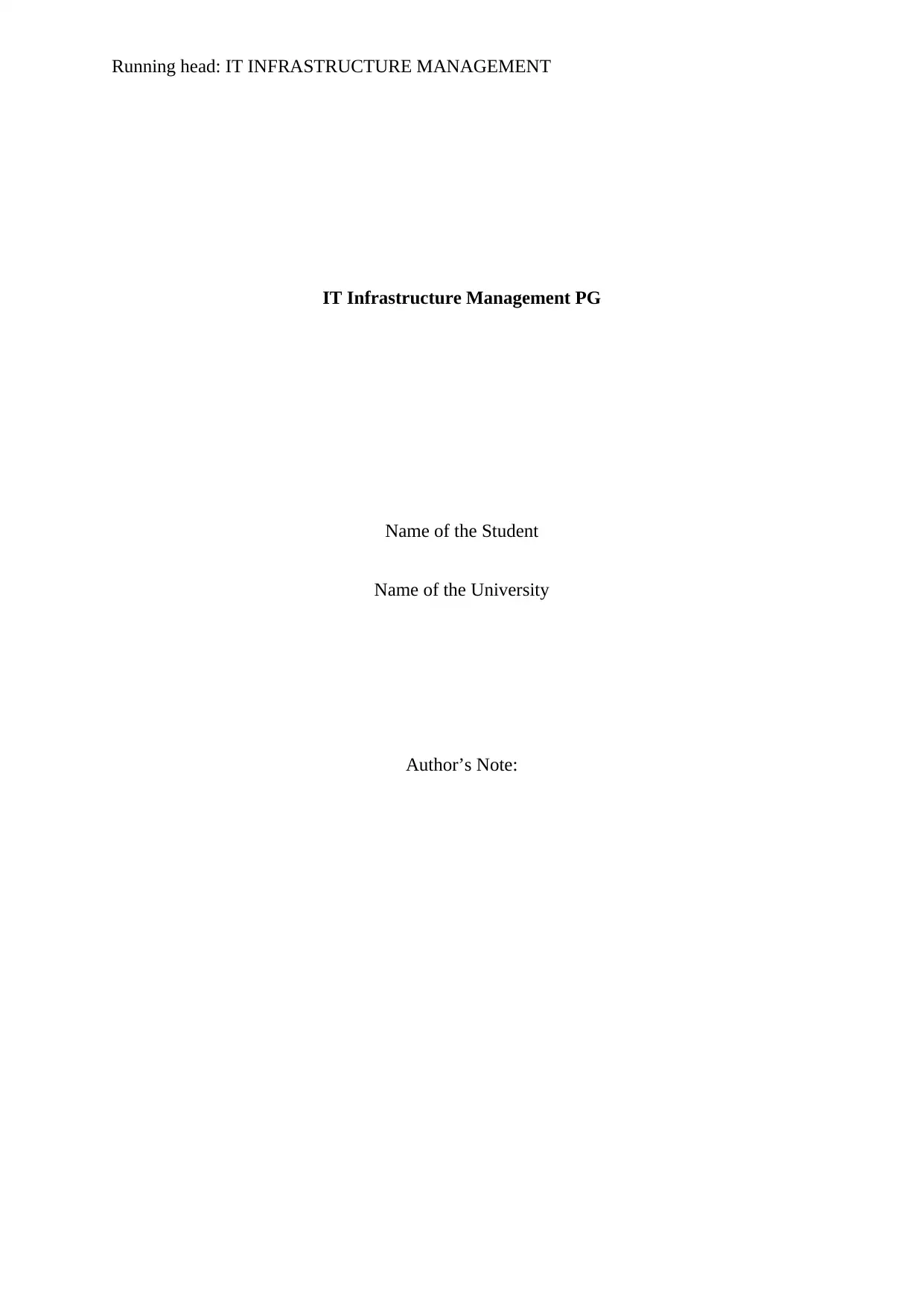
Running head: IT INFRASTRUCTURE MANAGEMENT
IT Infrastructure Management PG
Name of the Student
Name of the University
Author’s Note:
IT Infrastructure Management PG
Name of the Student
Name of the University
Author’s Note:
Secure Best Marks with AI Grader
Need help grading? Try our AI Grader for instant feedback on your assignments.
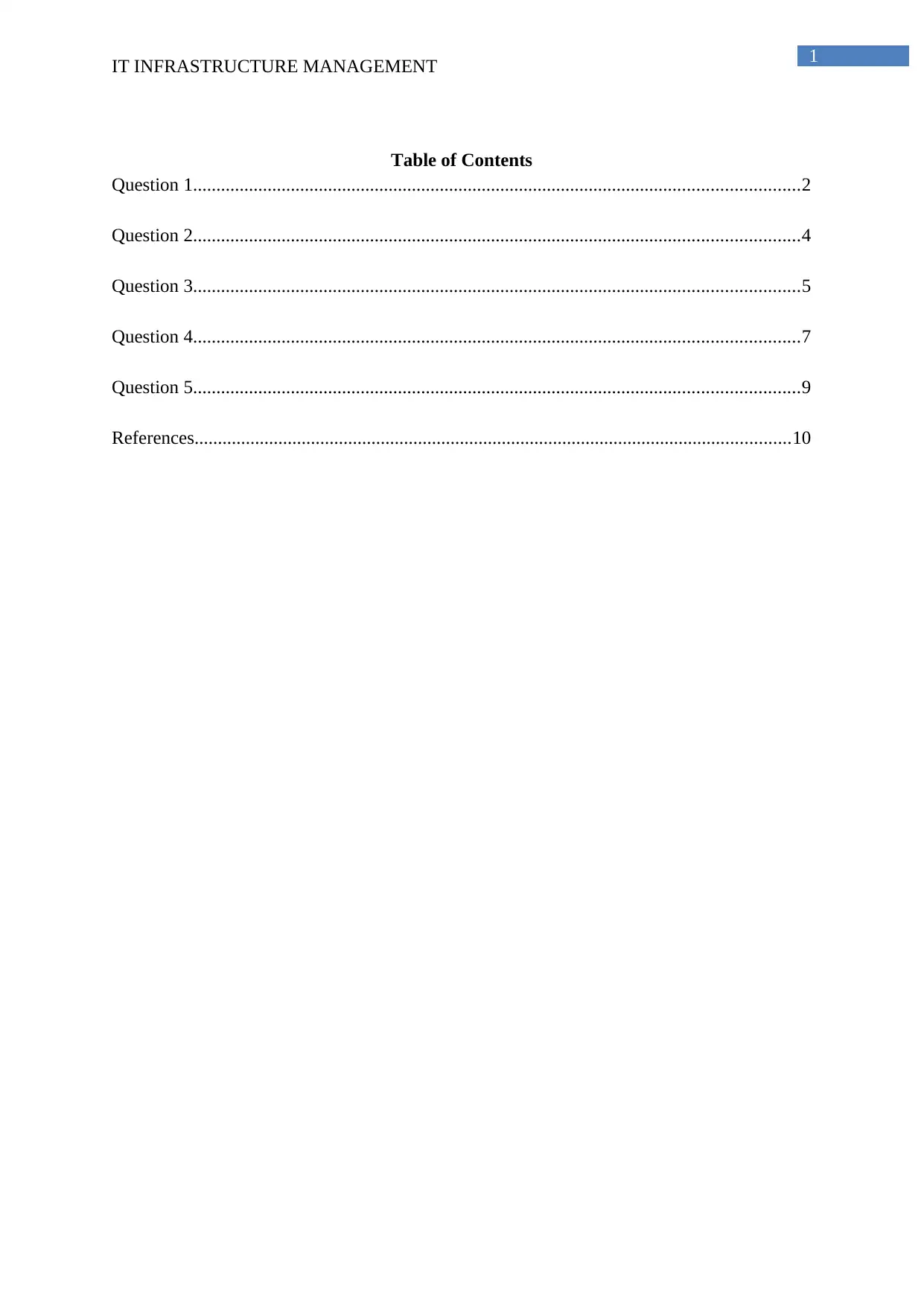
1
IT INFRASTRUCTURE MANAGEMENT
Table of Contents
Question 1..................................................................................................................................2
Question 2..................................................................................................................................4
Question 3..................................................................................................................................5
Question 4..................................................................................................................................7
Question 5..................................................................................................................................9
References................................................................................................................................10
IT INFRASTRUCTURE MANAGEMENT
Table of Contents
Question 1..................................................................................................................................2
Question 2..................................................................................................................................4
Question 3..................................................................................................................................5
Question 4..................................................................................................................................7
Question 5..................................................................................................................................9
References................................................................................................................................10
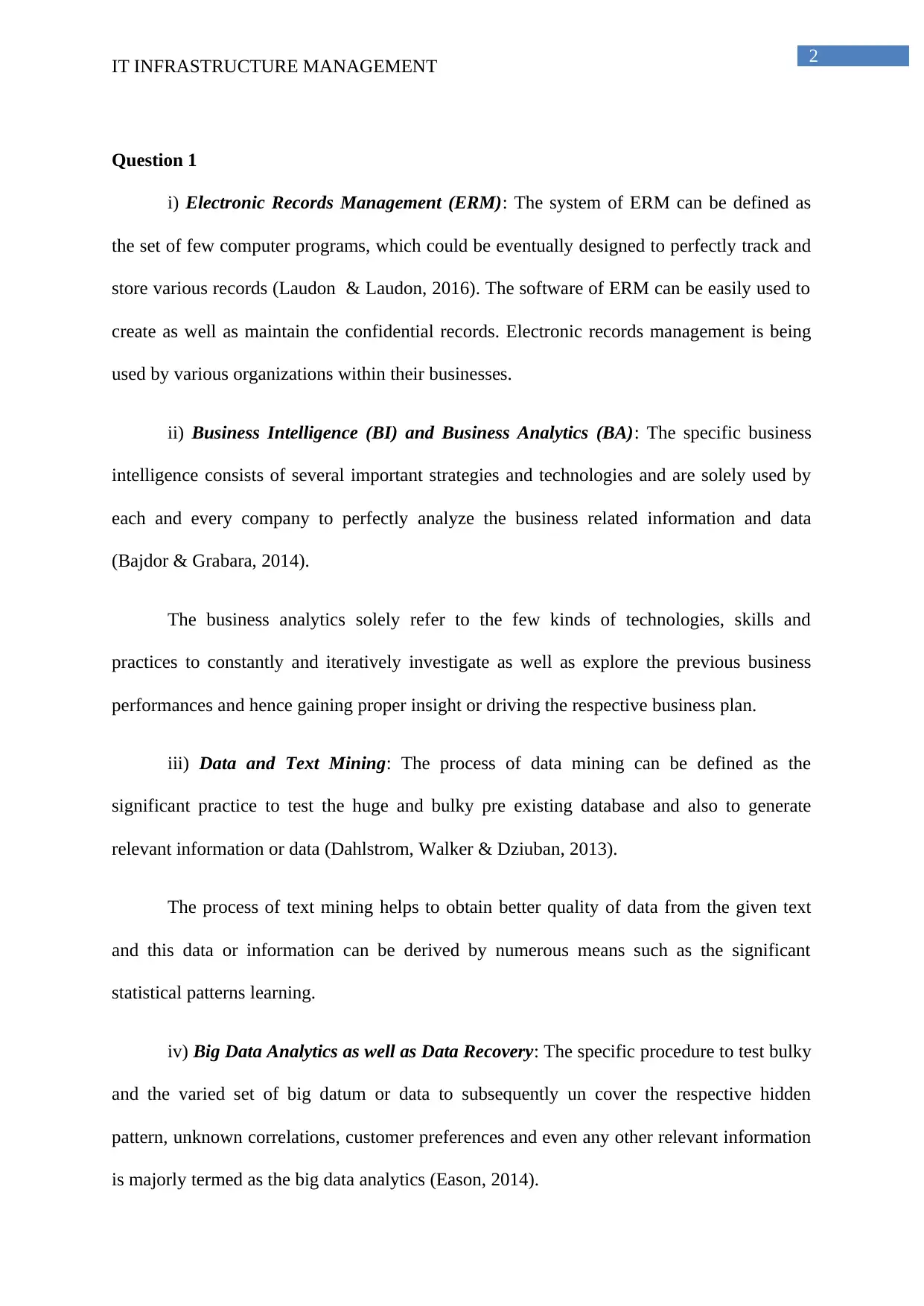
2
IT INFRASTRUCTURE MANAGEMENT
Question 1
i) Electronic Records Management (ERM): The system of ERM can be defined as
the set of few computer programs, which could be eventually designed to perfectly track and
store various records (Laudon & Laudon, 2016). The software of ERM can be easily used to
create as well as maintain the confidential records. Electronic records management is being
used by various organizations within their businesses.
ii) Business Intelligence (BI) and Business Analytics (BA): The specific business
intelligence consists of several important strategies and technologies and are solely used by
each and every company to perfectly analyze the business related information and data
(Bajdor & Grabara, 2014).
The business analytics solely refer to the few kinds of technologies, skills and
practices to constantly and iteratively investigate as well as explore the previous business
performances and hence gaining proper insight or driving the respective business plan.
iii) Data and Text Mining: The process of data mining can be defined as the
significant practice to test the huge and bulky pre existing database and also to generate
relevant information or data (Dahlstrom, Walker & Dziuban, 2013).
The process of text mining helps to obtain better quality of data from the given text
and this data or information can be derived by numerous means such as the significant
statistical patterns learning.
iv) Big Data Analytics as well as Data Recovery: The specific procedure to test bulky
and the varied set of big datum or data to subsequently un cover the respective hidden
pattern, unknown correlations, customer preferences and even any other relevant information
is majorly termed as the big data analytics (Eason, 2014).
IT INFRASTRUCTURE MANAGEMENT
Question 1
i) Electronic Records Management (ERM): The system of ERM can be defined as
the set of few computer programs, which could be eventually designed to perfectly track and
store various records (Laudon & Laudon, 2016). The software of ERM can be easily used to
create as well as maintain the confidential records. Electronic records management is being
used by various organizations within their businesses.
ii) Business Intelligence (BI) and Business Analytics (BA): The specific business
intelligence consists of several important strategies and technologies and are solely used by
each and every company to perfectly analyze the business related information and data
(Bajdor & Grabara, 2014).
The business analytics solely refer to the few kinds of technologies, skills and
practices to constantly and iteratively investigate as well as explore the previous business
performances and hence gaining proper insight or driving the respective business plan.
iii) Data and Text Mining: The process of data mining can be defined as the
significant practice to test the huge and bulky pre existing database and also to generate
relevant information or data (Dahlstrom, Walker & Dziuban, 2013).
The process of text mining helps to obtain better quality of data from the given text
and this data or information can be derived by numerous means such as the significant
statistical patterns learning.
iv) Big Data Analytics as well as Data Recovery: The specific procedure to test bulky
and the varied set of big datum or data to subsequently un cover the respective hidden
pattern, unknown correlations, customer preferences and even any other relevant information
is majorly termed as the big data analytics (Eason, 2014).
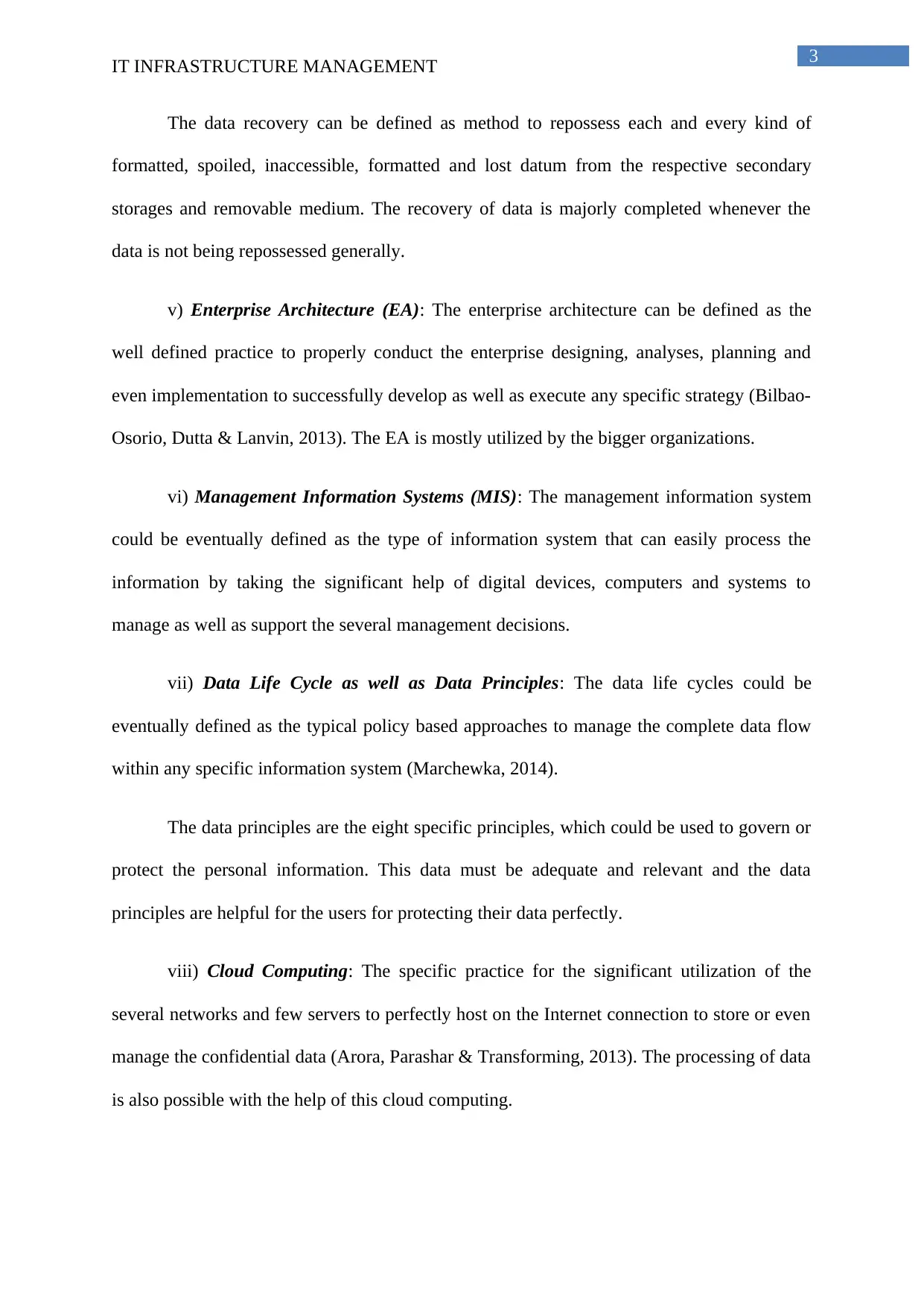
3
IT INFRASTRUCTURE MANAGEMENT
The data recovery can be defined as method to repossess each and every kind of
formatted, spoiled, inaccessible, formatted and lost datum from the respective secondary
storages and removable medium. The recovery of data is majorly completed whenever the
data is not being repossessed generally.
v) Enterprise Architecture (EA): The enterprise architecture can be defined as the
well defined practice to properly conduct the enterprise designing, analyses, planning and
even implementation to successfully develop as well as execute any specific strategy (Bilbao-
Osorio, Dutta & Lanvin, 2013). The EA is mostly utilized by the bigger organizations.
vi) Management Information Systems (MIS): The management information system
could be eventually defined as the type of information system that can easily process the
information by taking the significant help of digital devices, computers and systems to
manage as well as support the several management decisions.
vii) Data Life Cycle as well as Data Principles: The data life cycles could be
eventually defined as the typical policy based approaches to manage the complete data flow
within any specific information system (Marchewka, 2014).
The data principles are the eight specific principles, which could be used to govern or
protect the personal information. This data must be adequate and relevant and the data
principles are helpful for the users for protecting their data perfectly.
viii) Cloud Computing: The specific practice for the significant utilization of the
several networks and few servers to perfectly host on the Internet connection to store or even
manage the confidential data (Arora, Parashar & Transforming, 2013). The processing of data
is also possible with the help of this cloud computing.
IT INFRASTRUCTURE MANAGEMENT
The data recovery can be defined as method to repossess each and every kind of
formatted, spoiled, inaccessible, formatted and lost datum from the respective secondary
storages and removable medium. The recovery of data is majorly completed whenever the
data is not being repossessed generally.
v) Enterprise Architecture (EA): The enterprise architecture can be defined as the
well defined practice to properly conduct the enterprise designing, analyses, planning and
even implementation to successfully develop as well as execute any specific strategy (Bilbao-
Osorio, Dutta & Lanvin, 2013). The EA is mostly utilized by the bigger organizations.
vi) Management Information Systems (MIS): The management information system
could be eventually defined as the type of information system that can easily process the
information by taking the significant help of digital devices, computers and systems to
manage as well as support the several management decisions.
vii) Data Life Cycle as well as Data Principles: The data life cycles could be
eventually defined as the typical policy based approaches to manage the complete data flow
within any specific information system (Marchewka, 2014).
The data principles are the eight specific principles, which could be used to govern or
protect the personal information. This data must be adequate and relevant and the data
principles are helpful for the users for protecting their data perfectly.
viii) Cloud Computing: The specific practice for the significant utilization of the
several networks and few servers to perfectly host on the Internet connection to store or even
manage the confidential data (Arora, Parashar & Transforming, 2013). The processing of data
is also possible with the help of this cloud computing.
Secure Best Marks with AI Grader
Need help grading? Try our AI Grader for instant feedback on your assignments.
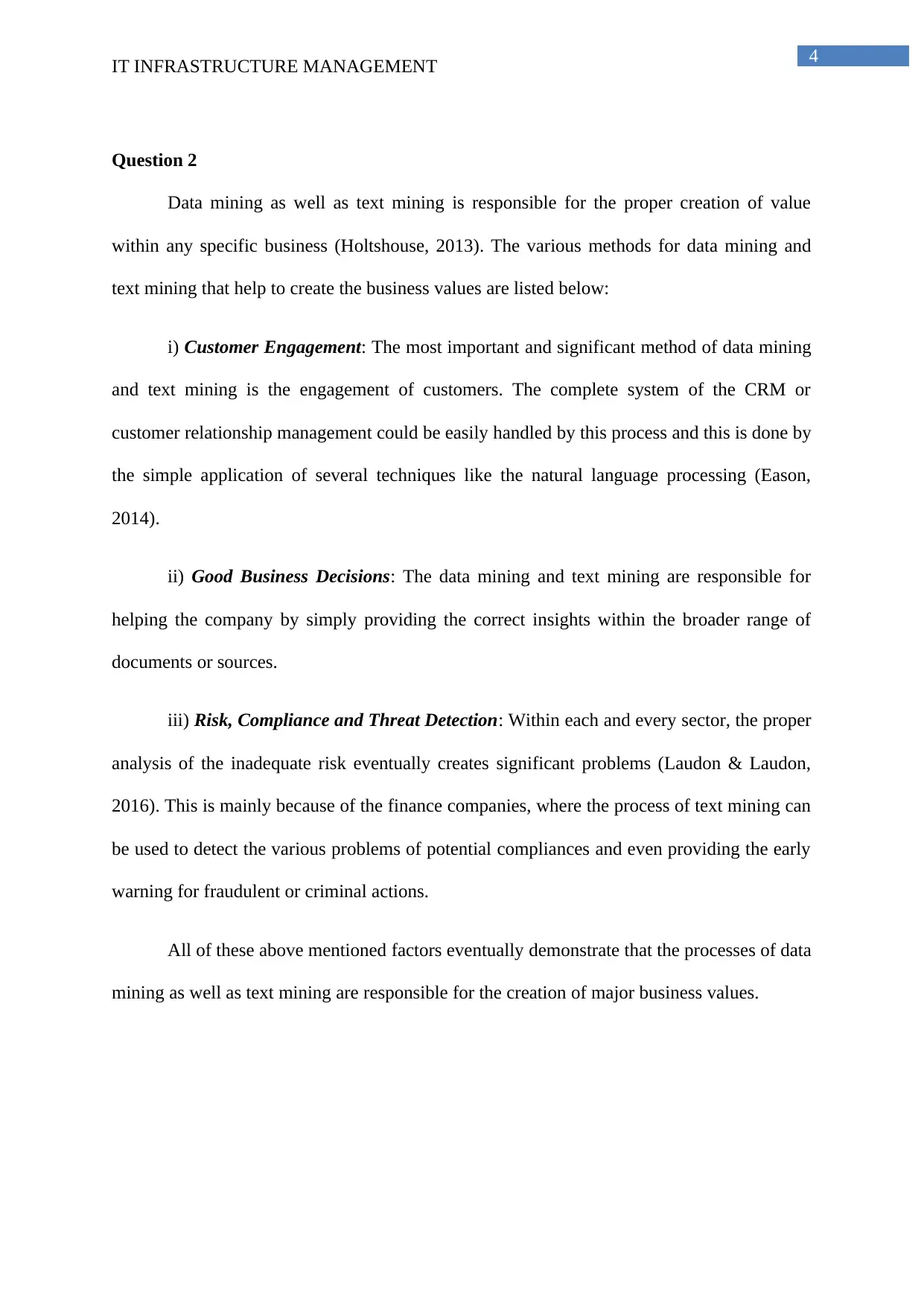
4
IT INFRASTRUCTURE MANAGEMENT
Question 2
Data mining as well as text mining is responsible for the proper creation of value
within any specific business (Holtshouse, 2013). The various methods for data mining and
text mining that help to create the business values are listed below:
i) Customer Engagement: The most important and significant method of data mining
and text mining is the engagement of customers. The complete system of the CRM or
customer relationship management could be easily handled by this process and this is done by
the simple application of several techniques like the natural language processing (Eason,
2014).
ii) Good Business Decisions: The data mining and text mining are responsible for
helping the company by simply providing the correct insights within the broader range of
documents or sources.
iii) Risk, Compliance and Threat Detection: Within each and every sector, the proper
analysis of the inadequate risk eventually creates significant problems (Laudon & Laudon,
2016). This is mainly because of the finance companies, where the process of text mining can
be used to detect the various problems of potential compliances and even providing the early
warning for fraudulent or criminal actions.
All of these above mentioned factors eventually demonstrate that the processes of data
mining as well as text mining are responsible for the creation of major business values.
IT INFRASTRUCTURE MANAGEMENT
Question 2
Data mining as well as text mining is responsible for the proper creation of value
within any specific business (Holtshouse, 2013). The various methods for data mining and
text mining that help to create the business values are listed below:
i) Customer Engagement: The most important and significant method of data mining
and text mining is the engagement of customers. The complete system of the CRM or
customer relationship management could be easily handled by this process and this is done by
the simple application of several techniques like the natural language processing (Eason,
2014).
ii) Good Business Decisions: The data mining and text mining are responsible for
helping the company by simply providing the correct insights within the broader range of
documents or sources.
iii) Risk, Compliance and Threat Detection: Within each and every sector, the proper
analysis of the inadequate risk eventually creates significant problems (Laudon & Laudon,
2016). This is mainly because of the finance companies, where the process of text mining can
be used to detect the various problems of potential compliances and even providing the early
warning for fraudulent or criminal actions.
All of these above mentioned factors eventually demonstrate that the processes of data
mining as well as text mining are responsible for the creation of major business values.
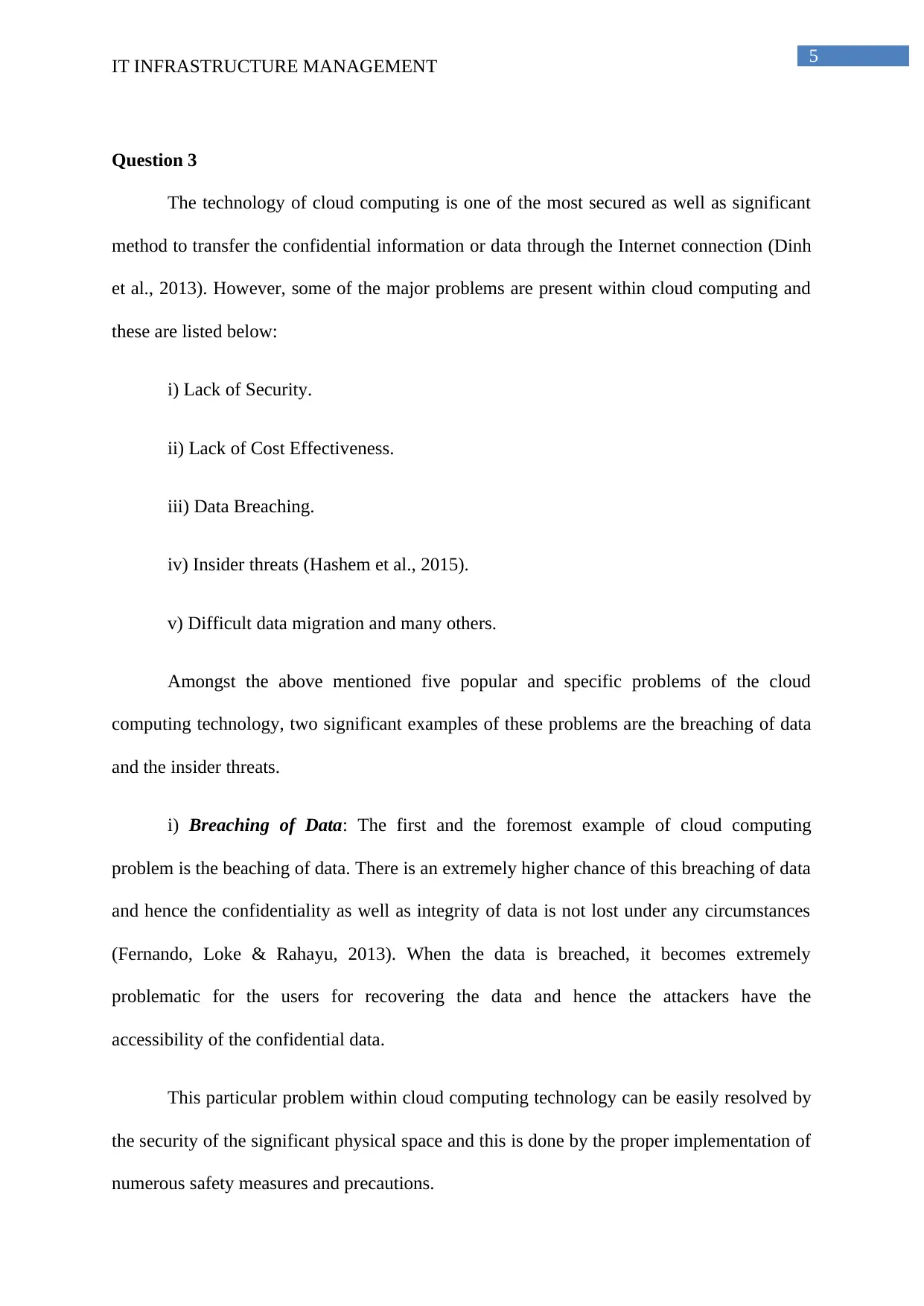
5
IT INFRASTRUCTURE MANAGEMENT
Question 3
The technology of cloud computing is one of the most secured as well as significant
method to transfer the confidential information or data through the Internet connection (Dinh
et al., 2013). However, some of the major problems are present within cloud computing and
these are listed below:
i) Lack of Security.
ii) Lack of Cost Effectiveness.
iii) Data Breaching.
iv) Insider threats (Hashem et al., 2015).
v) Difficult data migration and many others.
Amongst the above mentioned five popular and specific problems of the cloud
computing technology, two significant examples of these problems are the breaching of data
and the insider threats.
i) Breaching of Data: The first and the foremost example of cloud computing
problem is the beaching of data. There is an extremely higher chance of this breaching of data
and hence the confidentiality as well as integrity of data is not lost under any circumstances
(Fernando, Loke & Rahayu, 2013). When the data is breached, it becomes extremely
problematic for the users for recovering the data and hence the attackers have the
accessibility of the confidential data.
This particular problem within cloud computing technology can be easily resolved by
the security of the significant physical space and this is done by the proper implementation of
numerous safety measures and precautions.
IT INFRASTRUCTURE MANAGEMENT
Question 3
The technology of cloud computing is one of the most secured as well as significant
method to transfer the confidential information or data through the Internet connection (Dinh
et al., 2013). However, some of the major problems are present within cloud computing and
these are listed below:
i) Lack of Security.
ii) Lack of Cost Effectiveness.
iii) Data Breaching.
iv) Insider threats (Hashem et al., 2015).
v) Difficult data migration and many others.
Amongst the above mentioned five popular and specific problems of the cloud
computing technology, two significant examples of these problems are the breaching of data
and the insider threats.
i) Breaching of Data: The first and the foremost example of cloud computing
problem is the beaching of data. There is an extremely higher chance of this breaching of data
and hence the confidentiality as well as integrity of data is not lost under any circumstances
(Fernando, Loke & Rahayu, 2013). When the data is breached, it becomes extremely
problematic for the users for recovering the data and hence the attackers have the
accessibility of the confidential data.
This particular problem within cloud computing technology can be easily resolved by
the security of the significant physical space and this is done by the proper implementation of
numerous safety measures and precautions.
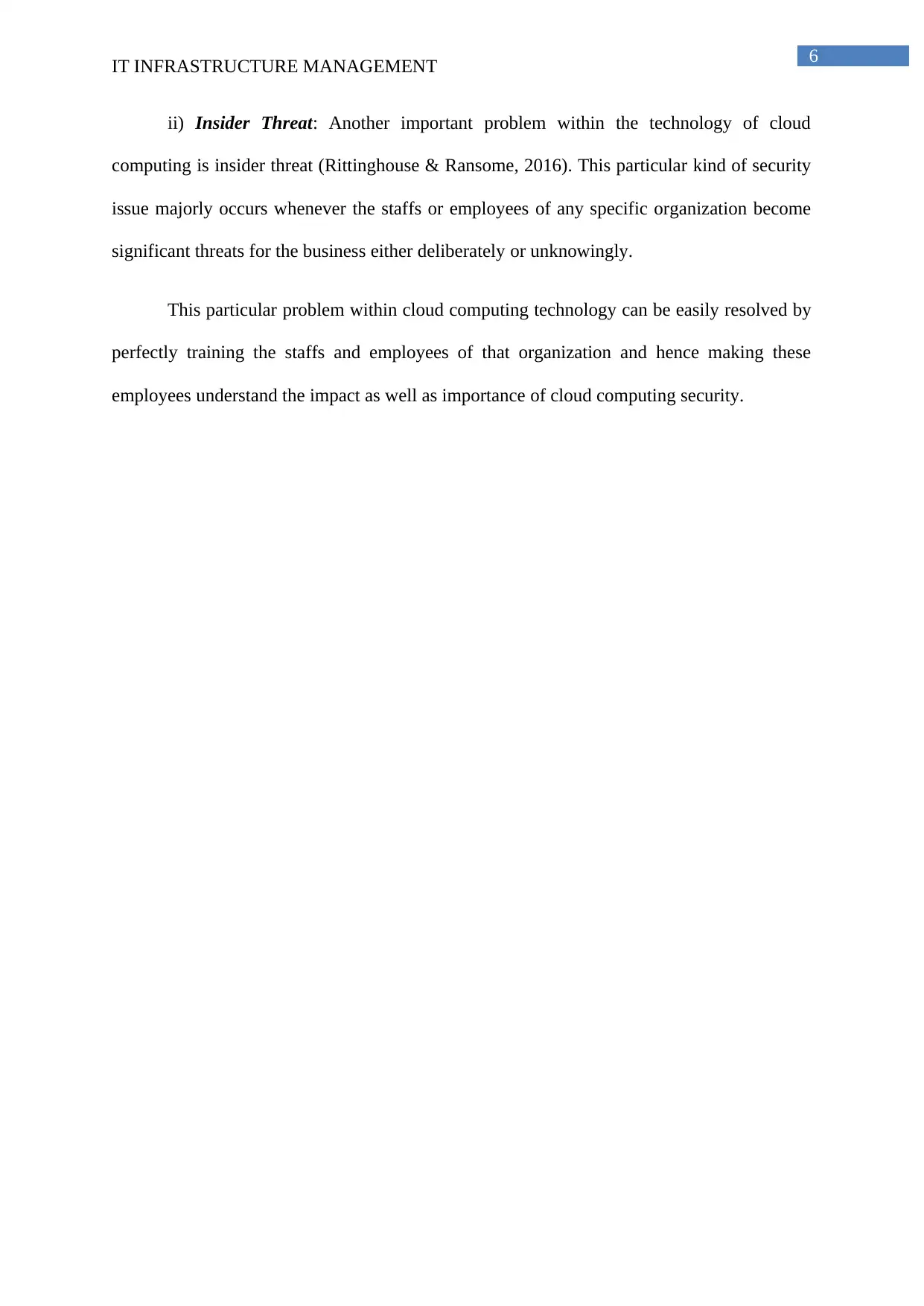
6
IT INFRASTRUCTURE MANAGEMENT
ii) Insider Threat: Another important problem within the technology of cloud
computing is insider threat (Rittinghouse & Ransome, 2016). This particular kind of security
issue majorly occurs whenever the staffs or employees of any specific organization become
significant threats for the business either deliberately or unknowingly.
This particular problem within cloud computing technology can be easily resolved by
perfectly training the staffs and employees of that organization and hence making these
employees understand the impact as well as importance of cloud computing security.
IT INFRASTRUCTURE MANAGEMENT
ii) Insider Threat: Another important problem within the technology of cloud
computing is insider threat (Rittinghouse & Ransome, 2016). This particular kind of security
issue majorly occurs whenever the staffs or employees of any specific organization become
significant threats for the business either deliberately or unknowingly.
This particular problem within cloud computing technology can be easily resolved by
perfectly training the staffs and employees of that organization and hence making these
employees understand the impact as well as importance of cloud computing security.
Paraphrase This Document
Need a fresh take? Get an instant paraphrase of this document with our AI Paraphraser
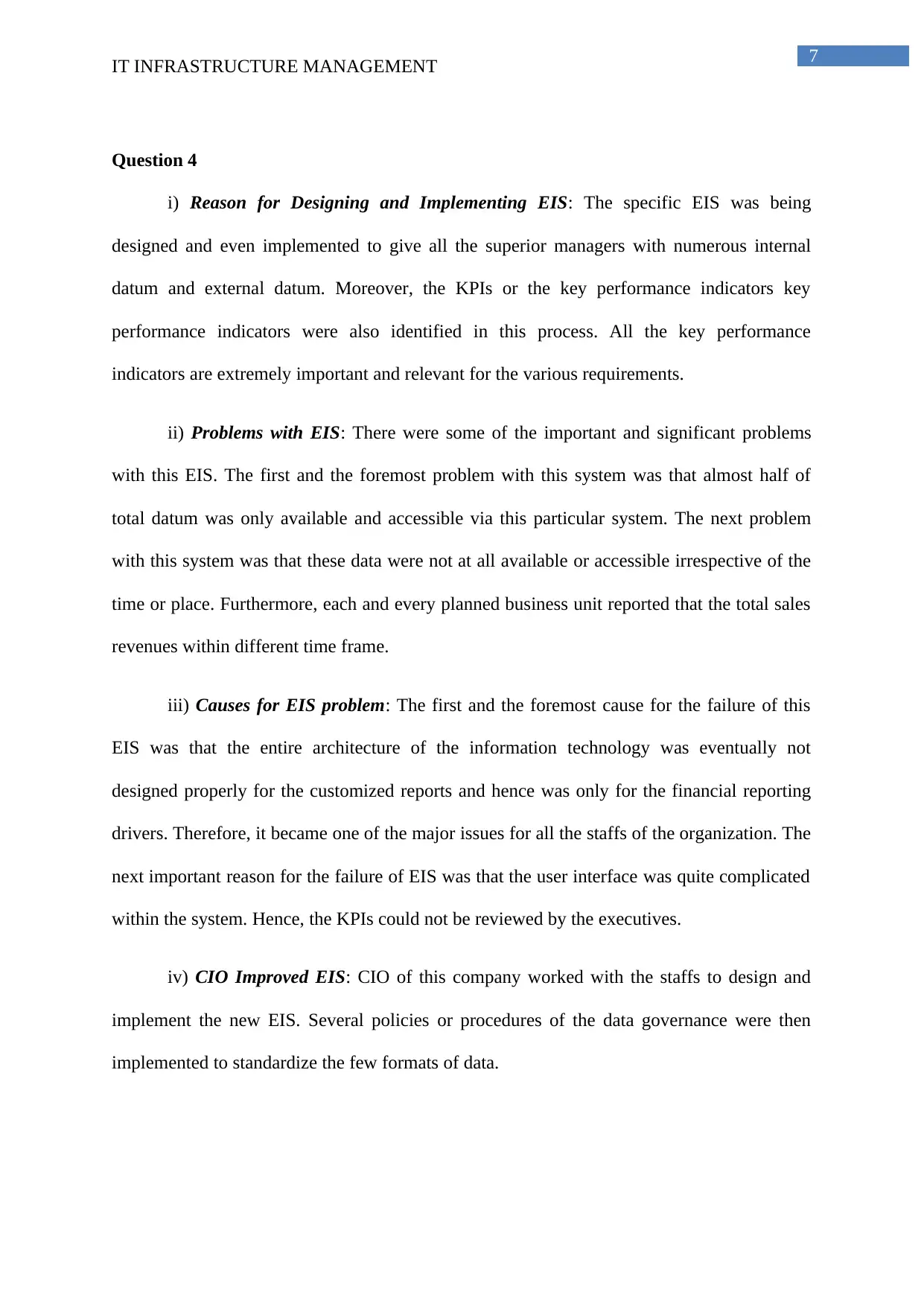
7
IT INFRASTRUCTURE MANAGEMENT
Question 4
i) Reason for Designing and Implementing EIS: The specific EIS was being
designed and even implemented to give all the superior managers with numerous internal
datum and external datum. Moreover, the KPIs or the key performance indicators key
performance indicators were also identified in this process. All the key performance
indicators are extremely important and relevant for the various requirements.
ii) Problems with EIS: There were some of the important and significant problems
with this EIS. The first and the foremost problem with this system was that almost half of
total datum was only available and accessible via this particular system. The next problem
with this system was that these data were not at all available or accessible irrespective of the
time or place. Furthermore, each and every planned business unit reported that the total sales
revenues within different time frame.
iii) Causes for EIS problem: The first and the foremost cause for the failure of this
EIS was that the entire architecture of the information technology was eventually not
designed properly for the customized reports and hence was only for the financial reporting
drivers. Therefore, it became one of the major issues for all the staffs of the organization. The
next important reason for the failure of EIS was that the user interface was quite complicated
within the system. Hence, the KPIs could not be reviewed by the executives.
iv) CIO Improved EIS: CIO of this company worked with the staffs to design and
implement the new EIS. Several policies or procedures of the data governance were then
implemented to standardize the few formats of data.
IT INFRASTRUCTURE MANAGEMENT
Question 4
i) Reason for Designing and Implementing EIS: The specific EIS was being
designed and even implemented to give all the superior managers with numerous internal
datum and external datum. Moreover, the KPIs or the key performance indicators key
performance indicators were also identified in this process. All the key performance
indicators are extremely important and relevant for the various requirements.
ii) Problems with EIS: There were some of the important and significant problems
with this EIS. The first and the foremost problem with this system was that almost half of
total datum was only available and accessible via this particular system. The next problem
with this system was that these data were not at all available or accessible irrespective of the
time or place. Furthermore, each and every planned business unit reported that the total sales
revenues within different time frame.
iii) Causes for EIS problem: The first and the foremost cause for the failure of this
EIS was that the entire architecture of the information technology was eventually not
designed properly for the customized reports and hence was only for the financial reporting
drivers. Therefore, it became one of the major issues for all the staffs of the organization. The
next important reason for the failure of EIS was that the user interface was quite complicated
within the system. Hence, the KPIs could not be reviewed by the executives.
iv) CIO Improved EIS: CIO of this company worked with the staffs to design and
implement the new EIS. Several policies or procedures of the data governance were then
implemented to standardize the few formats of data.

8
IT INFRASTRUCTURE MANAGEMENT
v) Advantages of new IT Architecture: This new architecture was completely
business driven and hence the report modification was easier. The time consumption was
eradicated by this and the costly ad hoc analysis was also eliminated.
vi) Advantages of Data Governance: One of the major advantage of the data
governance is that it helps in the management of data to validate the accuracy as per
standards, rules and requirements.
IT INFRASTRUCTURE MANAGEMENT
v) Advantages of new IT Architecture: This new architecture was completely
business driven and hence the report modification was easier. The time consumption was
eradicated by this and the costly ad hoc analysis was also eliminated.
vi) Advantages of Data Governance: One of the major advantage of the data
governance is that it helps in the management of data to validate the accuracy as per
standards, rules and requirements.
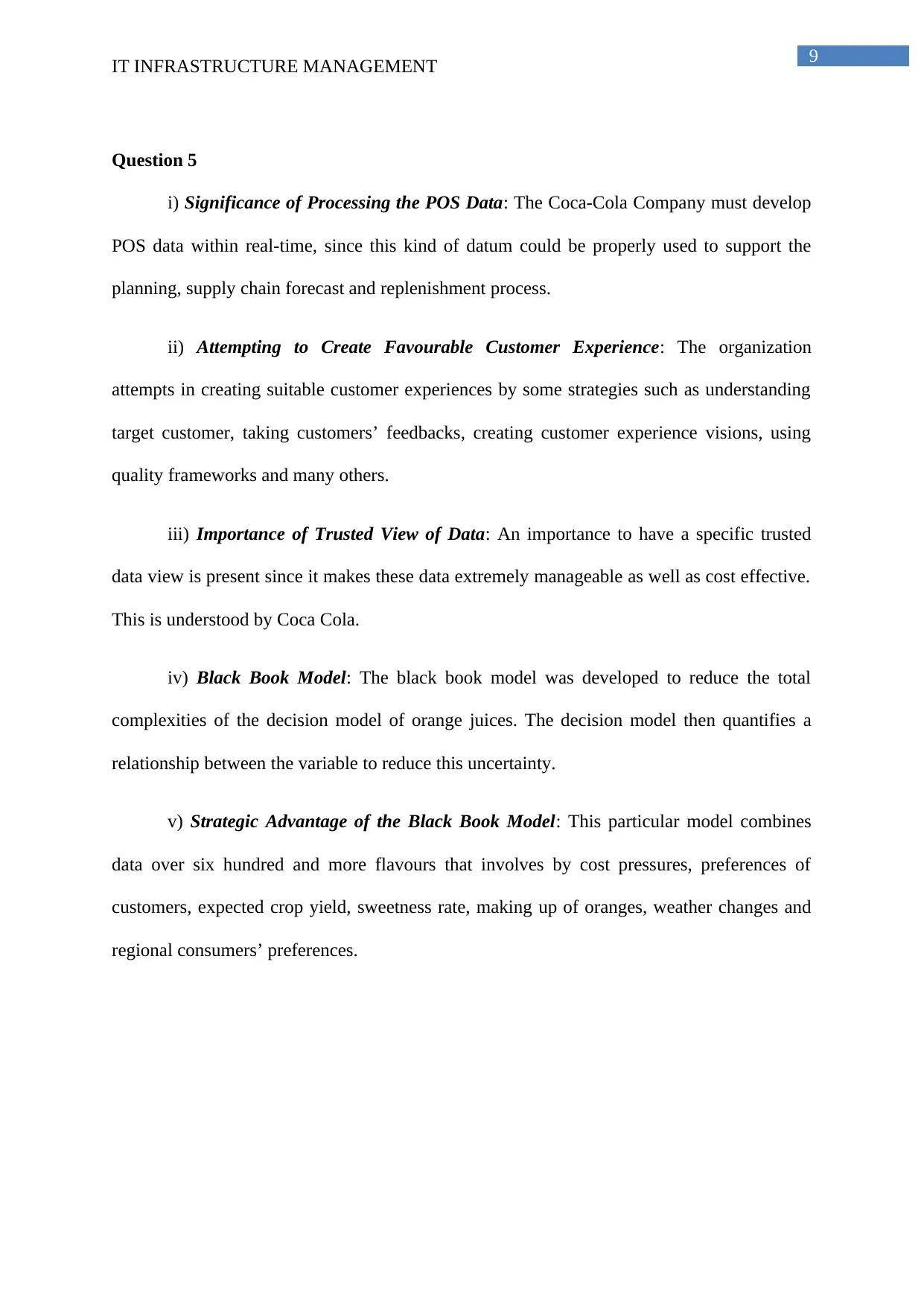
9
IT INFRASTRUCTURE MANAGEMENT
Question 5
i) Significance of Processing the POS Data: The Coca-Cola Company must develop
POS data within real-time, since this kind of datum could be properly used to support the
planning, supply chain forecast and replenishment process.
ii) Attempting to Create Favourable Customer Experience: The organization
attempts in creating suitable customer experiences by some strategies such as understanding
target customer, taking customers’ feedbacks, creating customer experience visions, using
quality frameworks and many others.
iii) Importance of Trusted View of Data: An importance to have a specific trusted
data view is present since it makes these data extremely manageable as well as cost effective.
This is understood by Coca Cola.
iv) Black Book Model: The black book model was developed to reduce the total
complexities of the decision model of orange juices. The decision model then quantifies a
relationship between the variable to reduce this uncertainty.
v) Strategic Advantage of the Black Book Model: This particular model combines
data over six hundred and more flavours that involves by cost pressures, preferences of
customers, expected crop yield, sweetness rate, making up of oranges, weather changes and
regional consumers’ preferences.
IT INFRASTRUCTURE MANAGEMENT
Question 5
i) Significance of Processing the POS Data: The Coca-Cola Company must develop
POS data within real-time, since this kind of datum could be properly used to support the
planning, supply chain forecast and replenishment process.
ii) Attempting to Create Favourable Customer Experience: The organization
attempts in creating suitable customer experiences by some strategies such as understanding
target customer, taking customers’ feedbacks, creating customer experience visions, using
quality frameworks and many others.
iii) Importance of Trusted View of Data: An importance to have a specific trusted
data view is present since it makes these data extremely manageable as well as cost effective.
This is understood by Coca Cola.
iv) Black Book Model: The black book model was developed to reduce the total
complexities of the decision model of orange juices. The decision model then quantifies a
relationship between the variable to reduce this uncertainty.
v) Strategic Advantage of the Black Book Model: This particular model combines
data over six hundred and more flavours that involves by cost pressures, preferences of
customers, expected crop yield, sweetness rate, making up of oranges, weather changes and
regional consumers’ preferences.
Secure Best Marks with AI Grader
Need help grading? Try our AI Grader for instant feedback on your assignments.
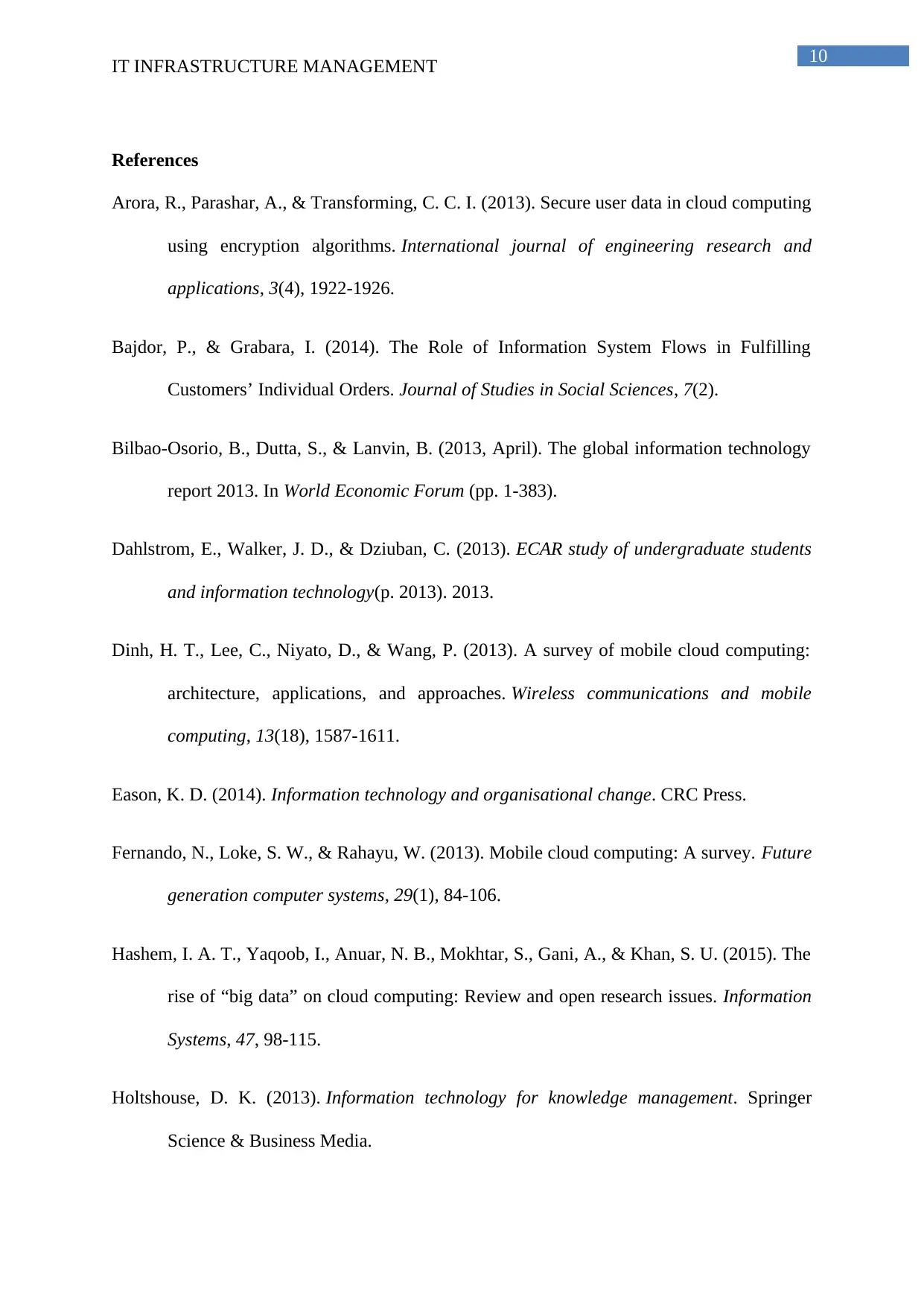
10
IT INFRASTRUCTURE MANAGEMENT
References
Arora, R., Parashar, A., & Transforming, C. C. I. (2013). Secure user data in cloud computing
using encryption algorithms. International journal of engineering research and
applications, 3(4), 1922-1926.
Bajdor, P., & Grabara, I. (2014). The Role of Information System Flows in Fulfilling
Customers’ Individual Orders. Journal of Studies in Social Sciences, 7(2).
Bilbao-Osorio, B., Dutta, S., & Lanvin, B. (2013, April). The global information technology
report 2013. In World Economic Forum (pp. 1-383).
Dahlstrom, E., Walker, J. D., & Dziuban, C. (2013). ECAR study of undergraduate students
and information technology(p. 2013). 2013.
Dinh, H. T., Lee, C., Niyato, D., & Wang, P. (2013). A survey of mobile cloud computing:
architecture, applications, and approaches. Wireless communications and mobile
computing, 13(18), 1587-1611.
Eason, K. D. (2014). Information technology and organisational change. CRC Press.
Fernando, N., Loke, S. W., & Rahayu, W. (2013). Mobile cloud computing: A survey. Future
generation computer systems, 29(1), 84-106.
Hashem, I. A. T., Yaqoob, I., Anuar, N. B., Mokhtar, S., Gani, A., & Khan, S. U. (2015). The
rise of “big data” on cloud computing: Review and open research issues. Information
Systems, 47, 98-115.
Holtshouse, D. K. (2013). Information technology for knowledge management. Springer
Science & Business Media.
IT INFRASTRUCTURE MANAGEMENT
References
Arora, R., Parashar, A., & Transforming, C. C. I. (2013). Secure user data in cloud computing
using encryption algorithms. International journal of engineering research and
applications, 3(4), 1922-1926.
Bajdor, P., & Grabara, I. (2014). The Role of Information System Flows in Fulfilling
Customers’ Individual Orders. Journal of Studies in Social Sciences, 7(2).
Bilbao-Osorio, B., Dutta, S., & Lanvin, B. (2013, April). The global information technology
report 2013. In World Economic Forum (pp. 1-383).
Dahlstrom, E., Walker, J. D., & Dziuban, C. (2013). ECAR study of undergraduate students
and information technology(p. 2013). 2013.
Dinh, H. T., Lee, C., Niyato, D., & Wang, P. (2013). A survey of mobile cloud computing:
architecture, applications, and approaches. Wireless communications and mobile
computing, 13(18), 1587-1611.
Eason, K. D. (2014). Information technology and organisational change. CRC Press.
Fernando, N., Loke, S. W., & Rahayu, W. (2013). Mobile cloud computing: A survey. Future
generation computer systems, 29(1), 84-106.
Hashem, I. A. T., Yaqoob, I., Anuar, N. B., Mokhtar, S., Gani, A., & Khan, S. U. (2015). The
rise of “big data” on cloud computing: Review and open research issues. Information
Systems, 47, 98-115.
Holtshouse, D. K. (2013). Information technology for knowledge management. Springer
Science & Business Media.
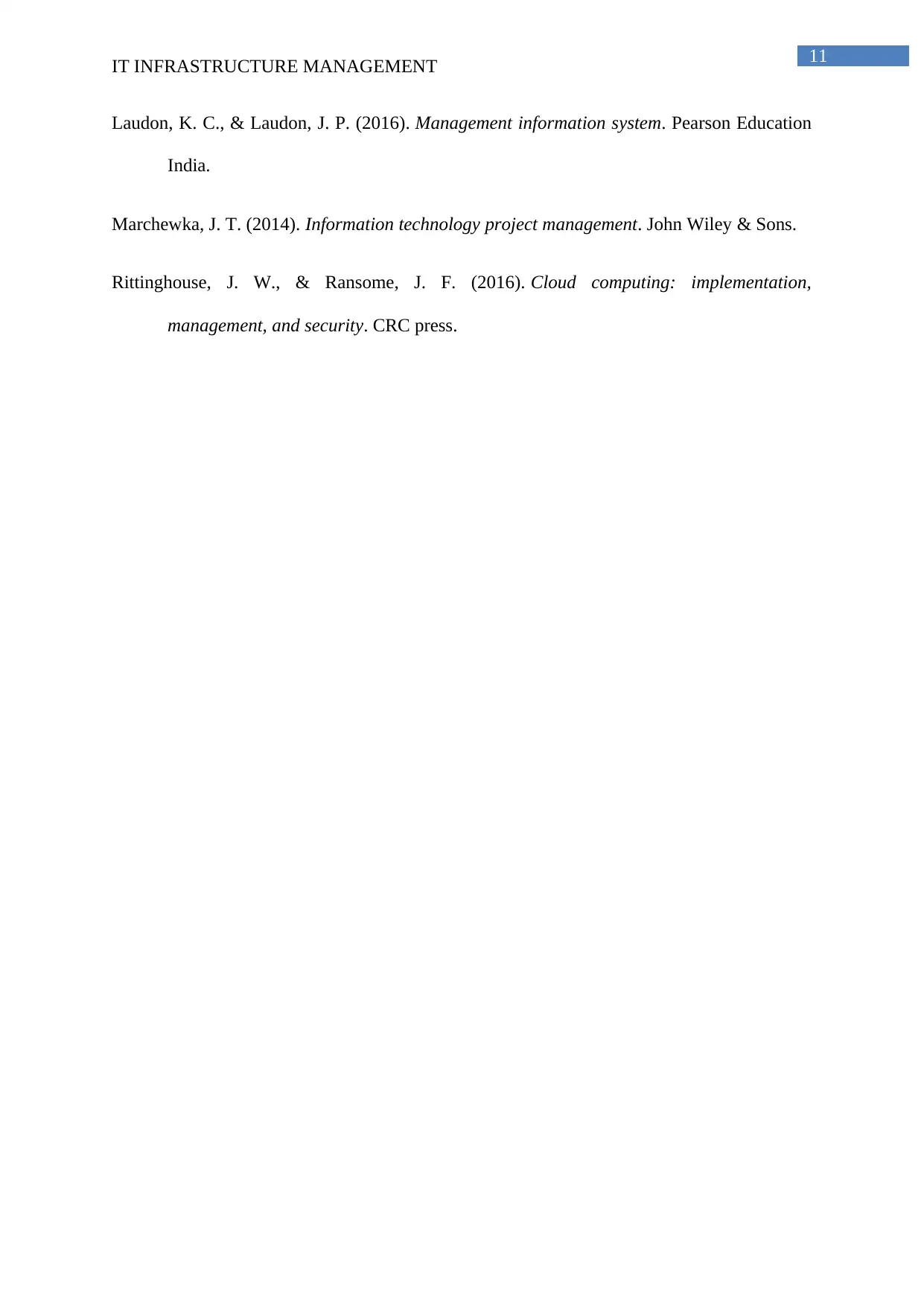
11
IT INFRASTRUCTURE MANAGEMENT
Laudon, K. C., & Laudon, J. P. (2016). Management information system. Pearson Education
India.
Marchewka, J. T. (2014). Information technology project management. John Wiley & Sons.
Rittinghouse, J. W., & Ransome, J. F. (2016). Cloud computing: implementation,
management, and security. CRC press.
IT INFRASTRUCTURE MANAGEMENT
Laudon, K. C., & Laudon, J. P. (2016). Management information system. Pearson Education
India.
Marchewka, J. T. (2014). Information technology project management. John Wiley & Sons.
Rittinghouse, J. W., & Ransome, J. F. (2016). Cloud computing: implementation,
management, and security. CRC press.
1 out of 12
Related Documents
Your All-in-One AI-Powered Toolkit for Academic Success.
+13062052269
info@desklib.com
Available 24*7 on WhatsApp / Email
![[object Object]](/_next/static/media/star-bottom.7253800d.svg)
Unlock your academic potential
© 2024 | Zucol Services PVT LTD | All rights reserved.


